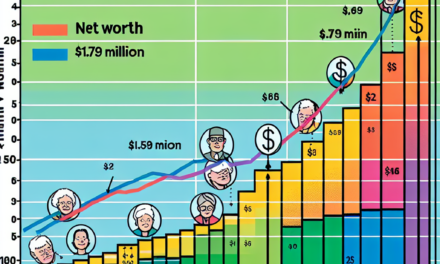“Volatility Reigns: Markets Teeter on Fed Speculation”
Introduction
On a day marked by volatility, global markets experienced a rollercoaster of fluctuations as investors grappled with speculation surrounding the Federal Reserve’s next moves. The trading session was characterized by sharp swings, reflecting the uncertainty and anticipation that have gripped financial markets. As traders parsed through economic data and Fed officials’ statements, the tug-of-war between bulls and bears intensified, leading to a see-saw pattern in major indices. This dynamic environment underscored the heightened sensitivity of market participants to any hints of policy shifts, as they sought to position themselves ahead of potential changes in interest rates and monetary policy.
Impact Of Federal Reserve Speculation On Market Volatility
The financial markets experienced a tumultuous trading day as investors grappled with speculation surrounding the Federal Reserve’s next moves. This volatility was largely driven by uncertainty over potential interest rate adjustments, which have become a focal point for traders and analysts alike. As the day unfolded, market participants were keenly attuned to any signals that might hint at the Federal Reserve’s future policy direction, leading to a see-saw pattern in stock prices.
Initially, the markets opened on a cautious note, reflecting the apprehension that has been building over the past few weeks. Investors have been closely monitoring economic indicators, such as employment data and inflation rates, to gauge the likelihood of the Federal Reserve altering its monetary policy stance. The anticipation of a possible interest rate hike has injected a degree of nervousness into the markets, as higher rates could potentially dampen economic growth and affect corporate earnings.
As the trading day progressed, a series of economic reports were released, providing fresh data for market participants to digest. These reports painted a mixed picture of the economy, with some indicators suggesting robust growth while others pointed to potential headwinds. This ambiguity only served to heighten the speculation surrounding the Federal Reserve’s next steps, as investors weighed the implications of each data point.
In response to the uncertainty, the markets exhibited significant volatility, with major indices swinging between gains and losses throughout the day. This see-saw pattern was emblematic of the broader sentiment among investors, who are grappling with the challenge of positioning themselves amid an unpredictable economic landscape. The heightened volatility also underscored the sensitivity of the markets to any developments related to Federal Reserve policy, as even minor shifts in expectations can trigger substantial market movements.
Adding to the complexity of the situation, comments from Federal Reserve officials further fueled speculation. While some officials hinted at the possibility of maintaining the current interest rate levels, others suggested that a rate hike might be necessary to curb inflationary pressures. This divergence in views among policymakers contributed to the uncertainty, as investors attempted to decipher the likely course of action.
Despite the volatility, some sectors managed to post gains, driven by company-specific news and earnings reports. However, these gains were often overshadowed by broader market movements, as the overarching narrative remained centered on Federal Reserve speculation. As the trading day drew to a close, the markets remained in a state of flux, with investors continuing to seek clarity on the central bank’s intentions.
In conclusion, the trading day was marked by significant volatility as markets reacted to ongoing speculation about the Federal Reserve’s future policy decisions. The interplay between economic data, Federal Reserve commentary, and investor sentiment created a dynamic environment, characterized by rapid shifts in market direction. As investors await further clarity, the potential for continued volatility remains high, underscoring the critical role that Federal Reserve policy plays in shaping market dynamics. Moving forward, market participants will likely remain vigilant, closely monitoring any developments that could provide insight into the central bank’s next moves.
Key Takeaways From The Latest Trading Day Amid Fed Uncertainty
The latest trading day was marked by significant volatility as markets reacted to ongoing speculation about the Federal Reserve’s future monetary policy decisions. Investors remained on edge, trying to decipher signals from the central bank regarding potential interest rate adjustments. This uncertainty led to a see-saw pattern in the markets, with indices experiencing sharp fluctuations throughout the day. As traders grappled with mixed economic data and Fed commentary, the financial landscape remained unpredictable.
Initially, the day began with a positive tone, as investors were buoyed by better-than-expected corporate earnings reports from several major companies. These earnings provided a temporary boost to market sentiment, suggesting that some sectors of the economy were performing well despite broader economic challenges. However, this optimism was short-lived as attention quickly shifted back to the Federal Reserve and its potential policy moves.
Midway through the trading session, comments from a key Federal Reserve official added to the uncertainty. The official hinted at the possibility of maintaining higher interest rates for a longer period, citing persistent inflationary pressures. This statement reignited concerns among investors about the impact of prolonged high rates on economic growth and corporate profitability. Consequently, the initial gains in the market began to erode, with major indices dipping into negative territory.
Adding to the complexity of the trading day, new economic data was released, painting a mixed picture of the current economic landscape. On one hand, consumer spending appeared robust, indicating that households were still willing to spend despite inflationary pressures. On the other hand, manufacturing output showed signs of slowing, raising concerns about the health of the industrial sector. This dichotomy in economic indicators further fueled the uncertainty, as investors struggled to assess the overall direction of the economy.
As the day progressed, market participants also kept a close eye on geopolitical developments, which added another layer of complexity to the trading environment. Tensions in key regions around the world have the potential to disrupt global supply chains and impact commodity prices, thereby influencing market dynamics. These geopolitical concerns, combined with domestic economic uncertainties, created a challenging backdrop for investors trying to navigate the markets.
Towards the end of the trading session, a slight recovery was observed as some investors took advantage of the earlier dip to buy stocks at lower prices. This buying activity helped stabilize the markets, although the overall sentiment remained cautious. The late-session rebound underscored the resilience of certain market participants who were willing to bet on a positive outcome despite the prevailing uncertainties.
In conclusion, the latest trading day was characterized by significant volatility driven by speculation about the Federal Reserve’s future actions. The interplay between corporate earnings, economic data, and Fed commentary created a complex environment for investors. As markets continue to react to these factors, the path forward remains uncertain. Investors will likely remain focused on upcoming economic reports and any further signals from the Federal Reserve, as they seek to navigate the challenging landscape. The day’s events highlighted the delicate balance between optimism and caution that currently defines market sentiment, with traders remaining vigilant amid ongoing uncertainty.
How Investors Are Reacting To Fed Speculation In The Markets
In recent trading sessions, financial markets have experienced significant volatility as investors grapple with speculation surrounding the Federal Reserve’s future monetary policy decisions. This uncertainty has led to a see-saw pattern in market movements, reflecting the broader sentiment of apprehension and anticipation among market participants. As investors attempt to decipher the Fed’s next steps, their reactions have been marked by a mix of caution and opportunism, influencing both equity and bond markets.
To begin with, the equity markets have been particularly sensitive to any hints or signals from the Federal Reserve regarding interest rate adjustments. Investors are acutely aware that any change in the interest rate environment can have profound implications for corporate earnings, borrowing costs, and overall economic growth. Consequently, even minor shifts in language or tone from Fed officials can trigger significant market responses. For instance, when Federal Reserve Chair Jerome Powell recently hinted at the possibility of maintaining higher interest rates for an extended period, equity markets reacted with a sharp decline. This response underscores the market’s sensitivity to the Fed’s policy outlook and the broader implications for economic conditions.
Moreover, the bond markets have also been impacted by the ongoing speculation surrounding the Federal Reserve’s actions. As investors seek to anticipate the Fed’s next move, bond yields have experienced fluctuations, reflecting changing expectations about future interest rates. When investors believe that the Fed may adopt a more hawkish stance, bond yields tend to rise as market participants demand higher returns to compensate for the anticipated increase in borrowing costs. Conversely, if the Fed signals a more dovish approach, bond yields may decline as investors adjust their expectations accordingly. This dynamic has contributed to the overall volatility observed in the bond markets, as investors continuously reassess their positions in response to evolving Fed signals.
In addition to the direct impact on equity and bond markets, the speculation surrounding the Federal Reserve’s policy decisions has also influenced investor sentiment more broadly. The uncertainty has led to a cautious approach among many investors, who are wary of making significant portfolio adjustments until there is greater clarity regarding the Fed’s intentions. This cautious stance is evident in the increased demand for safe-haven assets, such as gold and the U.S. dollar, as investors seek to mitigate potential risks associated with market volatility. At the same time, some investors have viewed the current environment as an opportunity to capitalize on market dislocations, employing strategies that take advantage of short-term price movements.
Furthermore, the ongoing speculation about the Federal Reserve’s policy trajectory has prompted investors to pay closer attention to economic data releases and other indicators that may provide insights into the Fed’s decision-making process. Key economic indicators, such as employment figures, inflation rates, and consumer spending data, have taken on added significance as investors attempt to gauge the health of the economy and the potential implications for monetary policy. This heightened focus on economic data has contributed to the day-to-day fluctuations in market sentiment, as investors react to new information and adjust their expectations accordingly.
In conclusion, the current environment of speculation surrounding the Federal Reserve’s future policy decisions has created a challenging landscape for investors. The resulting market volatility reflects the broader uncertainty and anticipation that characterize this period, as market participants navigate the complexities of an evolving economic landscape. As investors continue to react to Fed speculation, their responses will likely remain a key driver of market dynamics in the coming weeks and months.
Analyzing The See-Saw Movement Of Markets During Fed Speculation

The financial markets experienced a day of notable volatility as investors grappled with the implications of potential shifts in Federal Reserve policy. This see-saw movement was largely driven by speculation surrounding the central bank’s next steps in its ongoing efforts to manage inflation and support economic growth. As traders and analysts parsed through a myriad of economic indicators and statements from Fed officials, the markets oscillated between gains and losses, reflecting the uncertainty that currently pervades the financial landscape.
Initially, the day began with a sense of optimism as investors reacted to overnight developments in global markets. Positive economic data from Europe and Asia provided a temporary boost to sentiment, suggesting that the global economy might be on a more stable footing than previously anticipated. This optimism was further bolstered by corporate earnings reports that exceeded expectations, particularly in the technology and consumer goods sectors. As a result, major indices opened higher, with the S&P 500 and Nasdaq Composite showing early gains.
However, as the trading day progressed, attention shifted back to the United States, where the focus was squarely on the Federal Reserve. Recent comments from several Fed officials had hinted at the possibility of a more aggressive stance on interest rates, should inflationary pressures continue to mount. This prospect of tighter monetary policy injected a degree of caution into the markets, as investors weighed the potential impact on economic growth and corporate profitability. Consequently, the initial gains began to erode, and the markets entered a period of heightened volatility.
Adding to the uncertainty was the release of the latest consumer price index (CPI) data, which showed a slight uptick in inflation. While the increase was not entirely unexpected, it reinforced concerns that the Fed might need to act sooner rather than later to rein in price pressures. This data point served as a catalyst for further market fluctuations, as traders adjusted their positions in anticipation of possible policy changes. The bond market, in particular, saw significant movement, with yields on U.S. Treasury securities rising as investors priced in the likelihood of future rate hikes.
Despite these challenges, there were pockets of resilience within the market. Defensive sectors, such as utilities and healthcare, attracted investor interest as market participants sought refuge from the broader volatility. Additionally, some growth-oriented stocks managed to hold their ground, buoyed by strong earnings reports and positive forward guidance. This divergence in performance underscored the complexity of the current market environment, where sector-specific dynamics can play a crucial role in shaping overall trends.
As the trading day drew to a close, the markets remained in a state of flux, with major indices ending the session mixed. The Dow Jones Industrial Average managed to eke out a modest gain, while the S&P 500 and Nasdaq Composite posted slight declines. This outcome reflected the ongoing tug-of-war between bullish and bearish forces, as investors continued to navigate the uncertain terrain shaped by Fed speculation.
In conclusion, the see-saw movement of the markets during this period of Fed speculation highlights the intricate interplay between economic data, central bank policy, and investor sentiment. As market participants await further clarity from the Federal Reserve, the potential for continued volatility remains high. In this environment, a cautious and well-informed approach will be essential for navigating the challenges and opportunities that lie ahead.
Strategies For Navigating Market Fluctuations Amid Fed Speculation
In the ever-evolving landscape of financial markets, investors often find themselves navigating through periods of volatility, particularly when speculation surrounds the Federal Reserve’s monetary policy decisions. The recent trading day exemplified this dynamic, as markets experienced significant fluctuations driven by anticipation and uncertainty regarding the Fed’s next moves. Understanding strategies to manage such market conditions is crucial for investors aiming to safeguard their portfolios and capitalize on potential opportunities.
To begin with, it is essential to recognize that market volatility, while often unsettling, can present both risks and opportunities. During periods of heightened speculation about the Federal Reserve’s actions, markets tend to react sharply to any hints or signals from policymakers. This was evident in the recent trading session, where investors closely scrutinized every statement and economic indicator for clues about the Fed’s future policy direction. In such an environment, maintaining a diversified portfolio becomes a fundamental strategy. Diversification helps mitigate risk by spreading investments across various asset classes, sectors, and geographies, thereby reducing the impact of adverse movements in any single market segment.
Moreover, adopting a long-term perspective can be advantageous when navigating market fluctuations. Short-term volatility, often driven by speculation and sentiment, may not necessarily reflect the underlying fundamentals of the economy or individual companies. By focusing on long-term investment goals and maintaining discipline, investors can avoid making impulsive decisions based on temporary market swings. This approach allows them to stay committed to their investment strategy, even amid uncertainty surrounding the Federal Reserve’s policy decisions.
In addition to diversification and a long-term outlook, staying informed is paramount. Investors should keep abreast of economic data releases, Federal Reserve statements, and other relevant news that could influence market sentiment. By understanding the broader economic context and the Fed’s potential policy responses, investors can make more informed decisions. This knowledge enables them to anticipate market reactions and adjust their strategies accordingly, whether that involves rebalancing their portfolios or seeking opportunities in undervalued assets.
Furthermore, employing risk management techniques is crucial in times of market volatility. Utilizing stop-loss orders, for instance, can help protect against significant losses by automatically selling a security when it reaches a predetermined price. This strategy can be particularly useful when markets are unpredictable, as it provides a safety net while allowing investors to participate in potential upside movements. Additionally, options strategies, such as buying protective puts, can offer downside protection while maintaining exposure to potential gains.
Finally, consulting with financial advisors or investment professionals can provide valuable insights and guidance during uncertain times. These experts can offer personalized advice tailored to an investor’s risk tolerance, financial goals, and market outlook. By leveraging their expertise, investors can gain a deeper understanding of market dynamics and develop strategies that align with their individual circumstances.
In conclusion, navigating market fluctuations amid Federal Reserve speculation requires a multifaceted approach. By diversifying portfolios, maintaining a long-term perspective, staying informed, employing risk management techniques, and seeking professional advice, investors can better position themselves to weather volatility and seize opportunities. As markets continue to react to the ebb and flow of Fed speculation, these strategies can serve as a compass, guiding investors through the complexities of the financial landscape.
The Role Of Economic Indicators In Market Reactions To Fed News
In the ever-evolving landscape of financial markets, the role of economic indicators in shaping investor sentiment and market reactions cannot be overstated. As traders and investors navigate the complexities of market dynamics, they often look to economic indicators as a compass to guide their decisions, especially in the context of Federal Reserve announcements. The interplay between these indicators and Fed news creates a see-saw effect in the markets, as evidenced by the recent trading day fluctuations.
Economic indicators, such as employment figures, inflation rates, and GDP growth, serve as vital barometers of the economy’s health. These indicators provide insights into the underlying economic conditions that influence the Federal Reserve’s monetary policy decisions. For instance, a robust employment report may signal a strengthening economy, prompting the Fed to consider tightening monetary policy to prevent overheating. Conversely, weak economic data might lead the Fed to adopt a more accommodative stance to stimulate growth. Thus, the release of these indicators often triggers significant market movements as investors recalibrate their expectations regarding future Fed actions.
On a recent trading day, markets experienced a pronounced see-saw effect, oscillating between gains and losses as investors digested a slew of economic data and speculated on the Fed’s next move. Initially, the release of stronger-than-expected employment numbers fueled optimism, driving equities higher as investors anticipated a resilient economic recovery. However, this optimism was tempered by concerns that the Fed might accelerate its timeline for interest rate hikes, leading to a pullback in stock prices. This tug-of-war between bullish and bearish sentiments underscores the delicate balance that economic indicators strike in influencing market reactions.
Moreover, inflation data plays a pivotal role in shaping market expectations of Fed policy. As inflationary pressures mount, investors become increasingly vigilant, scrutinizing every data point for clues about the Fed’s response. In this context, the recent release of higher-than-anticipated inflation figures added another layer of complexity to the market’s see-saw dynamics. While some investors viewed the data as a sign of a robust economy capable of withstanding tighter monetary policy, others feared that persistent inflation could erode purchasing power and dampen economic growth. This divergence in interpretations further contributed to the market’s volatility.
In addition to employment and inflation data, GDP growth figures also hold significant sway over market reactions to Fed news. A strong GDP report can bolster investor confidence, suggesting that the economy is on a solid footing. However, it can also raise concerns about potential overheating, prompting speculation about the Fed’s willingness to intervene. On the recent trading day, GDP growth data added yet another dimension to the market’s see-saw pattern, as investors weighed the implications of robust economic expansion against the backdrop of potential Fed tightening.
In conclusion, the role of economic indicators in market reactions to Fed news is both profound and multifaceted. These indicators serve as critical inputs for investors as they navigate the complexities of market dynamics, influencing their expectations and driving market movements. The recent trading day’s see-saw pattern exemplifies the intricate interplay between economic data and Fed speculation, highlighting the challenges and opportunities that investors face in an ever-changing financial landscape. As markets continue to respond to the ebb and flow of economic indicators, understanding their impact remains essential for making informed investment decisions.
Comparing Historical Market Reactions To Federal Reserve Speculation
In the ever-evolving landscape of financial markets, the influence of the Federal Reserve’s monetary policy decisions cannot be overstated. Investors and analysts alike keenly observe the Fed’s every move, as even the slightest hint of a policy shift can send ripples through global markets. This phenomenon was once again on display during a recent trading day, where markets experienced a see-saw effect amid speculation about the Federal Reserve’s next steps. To better understand this dynamic, it is instructive to compare historical market reactions to similar periods of Fed speculation.
Historically, the Federal Reserve’s role in shaping market sentiment has been significant. For instance, during the 2008 financial crisis, the Fed’s decision to implement quantitative easing was met with a mixture of relief and skepticism. Initially, markets reacted positively, buoyed by the influx of liquidity. However, as the long-term implications of such unprecedented measures became apparent, volatility ensued. This pattern of initial optimism followed by uncertainty is a recurring theme in market reactions to Fed speculation.
Similarly, in the aftermath of the dot-com bubble in the early 2000s, the Federal Reserve’s interest rate cuts were closely scrutinized. Investors were eager to see how these measures would stimulate economic recovery. Initially, the markets responded with enthusiasm, as lower interest rates were expected to spur investment and consumer spending. However, as the economic recovery proved to be slower than anticipated, market sentiment shifted, leading to increased volatility.
Fast forward to the present day, and the pattern remains consistent. As speculation mounts regarding the Federal Reserve’s potential interest rate hikes or tapering of asset purchases, markets exhibit a familiar see-saw behavior. On one hand, investors are hopeful that the Fed’s actions will sustain economic growth and keep inflation in check. On the other hand, there is apprehension about the potential for higher borrowing costs and the impact on corporate profits.
Moreover, the global nature of today’s financial markets adds another layer of complexity to the equation. In an interconnected world, the Federal Reserve’s decisions reverberate far beyond U.S. borders. Emerging markets, in particular, are sensitive to changes in U.S. monetary policy, as they often rely on foreign capital inflows. Consequently, speculation about the Fed’s next move can lead to capital flight from these markets, exacerbating volatility.
In comparing historical market reactions to Federal Reserve speculation, it becomes evident that while the specifics of each situation may differ, the underlying dynamics remain remarkably consistent. Investors are perpetually caught between optimism and caution, as they attempt to anticipate the Fed’s actions and their implications for the broader economy. This delicate balance is further complicated by the myriad of factors that influence the Fed’s decision-making process, including economic data, geopolitical events, and fiscal policy.
In conclusion, the see-saw effect observed in markets amid Fed speculation is not a new phenomenon. Rather, it is a reflection of the complex interplay between investor sentiment, economic fundamentals, and monetary policy. By examining historical market reactions, we gain valuable insights into the challenges and opportunities that lie ahead. As the Federal Reserve continues to navigate the uncertain waters of economic recovery, market participants will undoubtedly remain vigilant, ready to adapt to whatever course the Fed ultimately charts.
Q&A
1. **Question:** What caused the markets to fluctuate on the trading day?
– **Answer:** The markets fluctuated due to speculation about the Federal Reserve’s future interest rate decisions.
2. **Question:** Which sectors were most affected by the market volatility?
– **Answer:** Technology and financial sectors were most affected by the market volatility.
3. **Question:** How did the major stock indices perform by the end of the trading day?
– **Answer:** The major stock indices ended the day with mixed results, with some indices slightly up and others slightly down.
4. **Question:** What specific comments or actions by the Federal Reserve influenced market behavior?
– **Answer:** Comments from Federal Reserve officials suggesting potential changes in interest rate policy influenced market behavior.
5. **Question:** Were there any significant economic data releases that impacted the markets?
– **Answer:** Yes, economic data releases such as employment figures and inflation rates impacted the markets.
6. **Question:** How did bond yields react to the speculation about the Federal Reserve?
– **Answer:** Bond yields experienced fluctuations, reflecting investor uncertainty about future interest rate changes.
7. **Question:** What was the general sentiment among investors regarding the Federal Reserve’s next moves?
– **Answer:** The general sentiment among investors was one of uncertainty and caution regarding the Federal Reserve’s next moves.
Conclusion
The trading day was characterized by volatility as markets reacted to ongoing speculation about the Federal Reserve’s future monetary policy decisions. Investors grappled with mixed economic signals and statements from Fed officials, leading to fluctuations in stock prices and bond yields. The uncertainty surrounding interest rate hikes and inflationary pressures contributed to the market’s see-saw movement, reflecting the broader uncertainty in the economic outlook. As traders continue to parse through economic data and Fed communications, market volatility is likely to persist until clearer guidance is provided.





